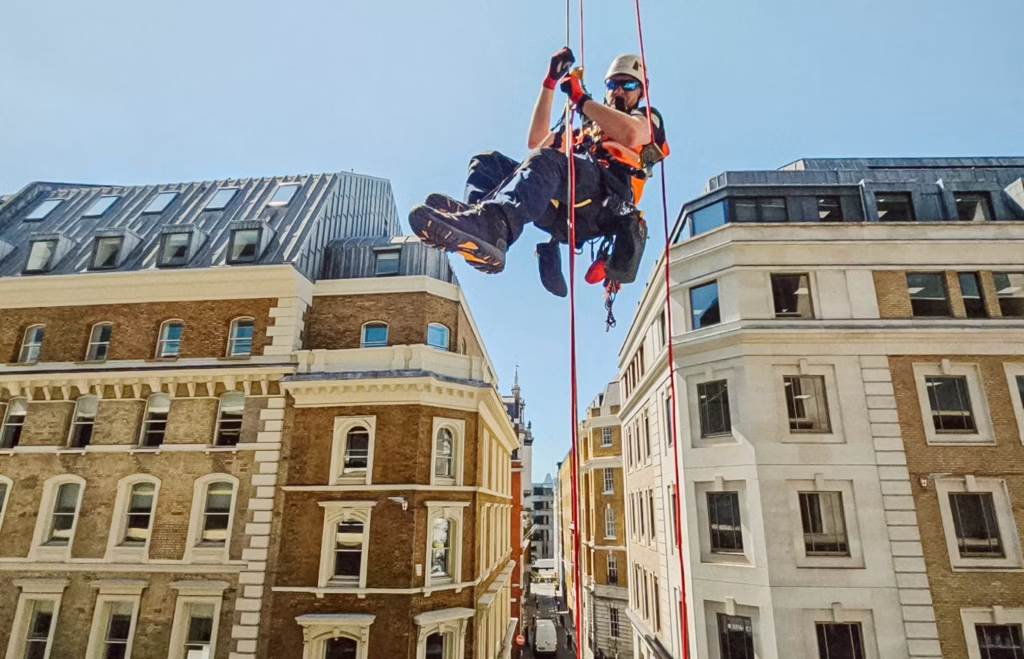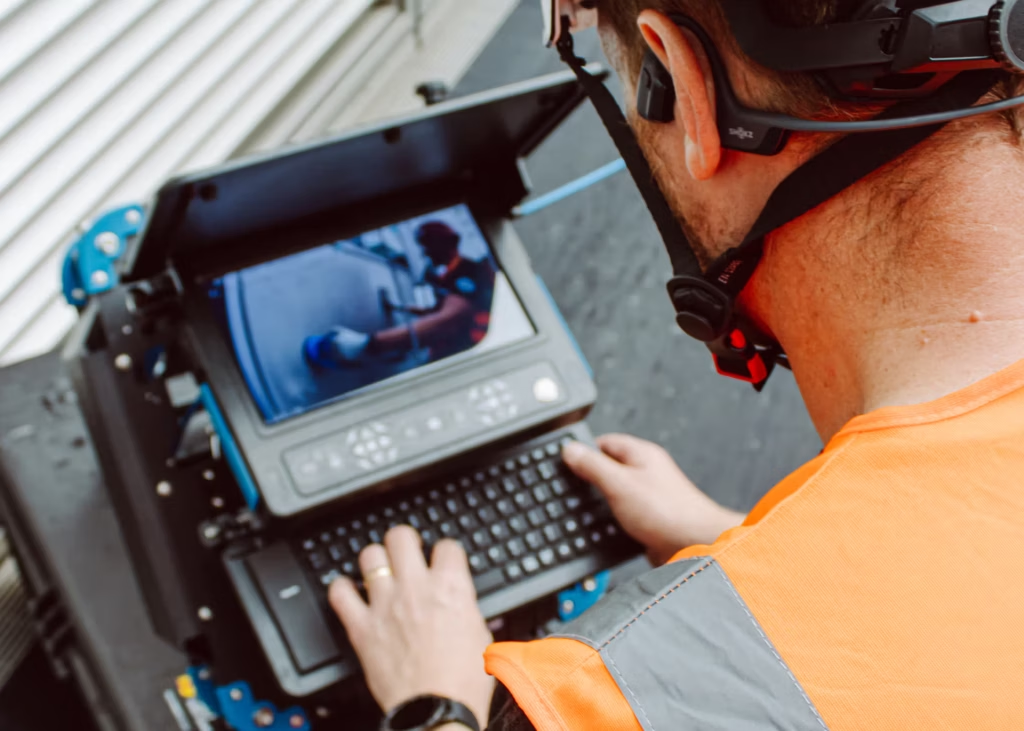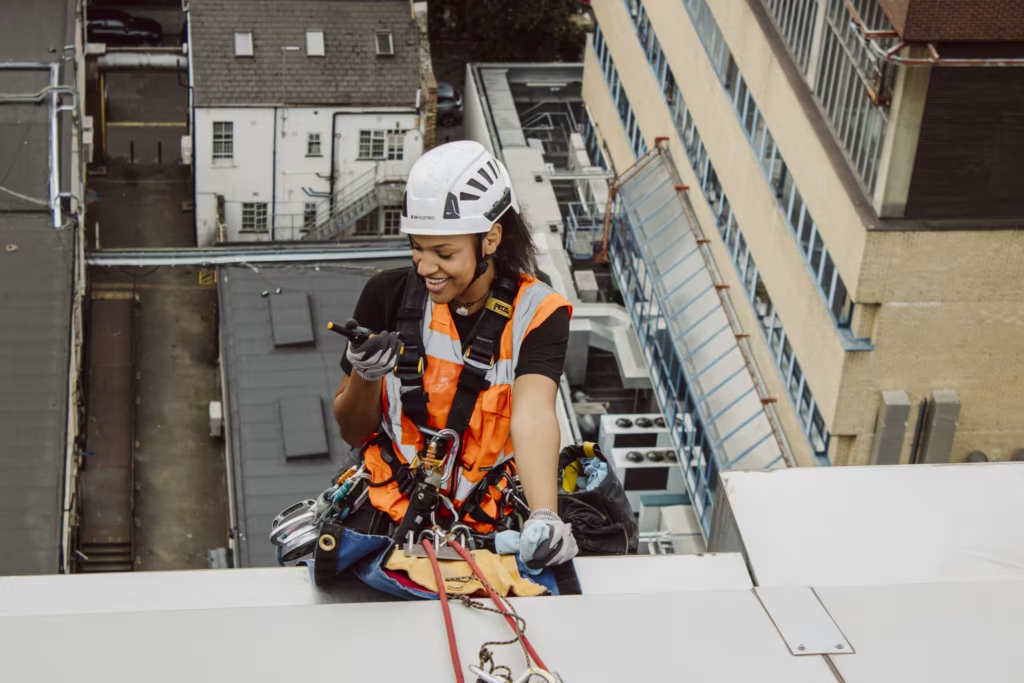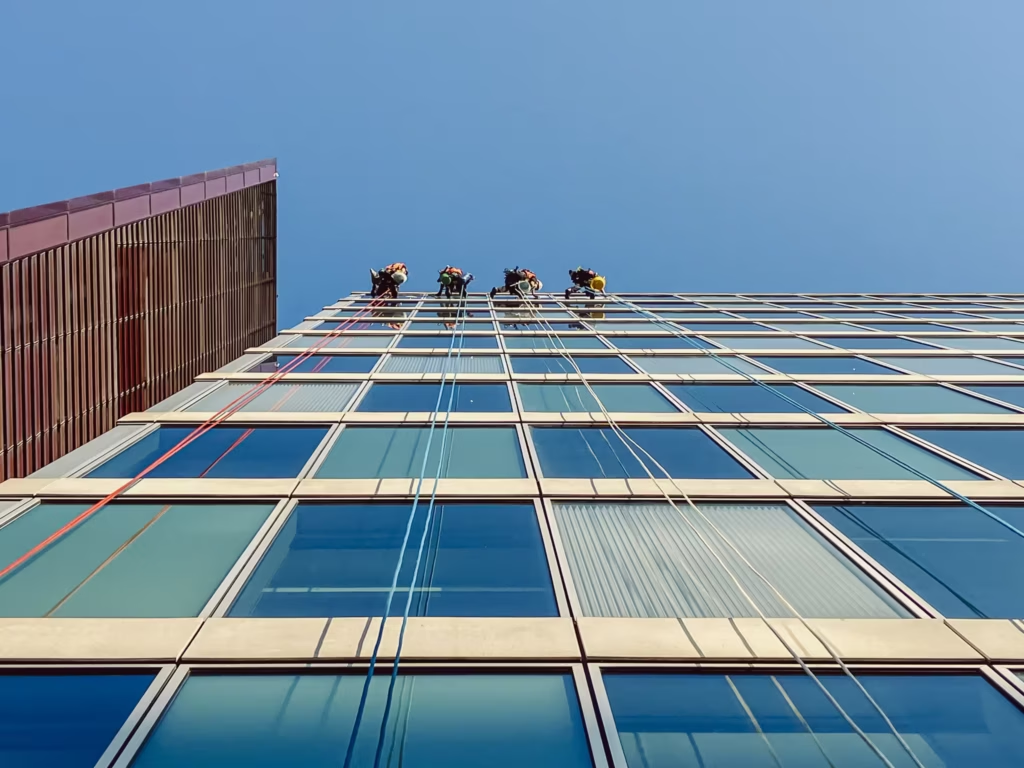When carrying out work at heights on commercial and heritage properties, the access method you choose can significantly impact project cost and safety outcomes. Rope access is sometimes seen as the faster, cheaper option, but as Gavin, our Specialist Access Manager, explains, there’s a lot more to it than two ropes and a harness.
We sat down with him to discuss safety, misconceptions, and what surveyors and building owners should know before choosing a rope access partner.
What exactly is rope access, and why do clients choose it?
“We always look for the safest and most efficient way to access a building,” Gavin begins. “Rope access has a niche but essential role, especially in cities like London, because it’s quick to set up, far less intrusive than scaffolding, and more cost-effective for short-term or complex façade work.”
Where scaffolding can block light, disrupt operations, and require weeks of build and dismantle time, rope access technicians can be mobilised within hours. It’s ideal for periodic façade inspection, localised CWCT testing, and preventive building maintenance in areas that are difficult to reach.
“The savings are significant,” Gavin says. “Cradle systems need ongoing maintenance contracts and can break down; rope access just needs secure anchor points. It gives surveyors and building managers a faster, cleaner route to reliable data.”

When is rope access the right solution, and when isn’t it?
“It’s perfect when scaffolding or MEWPs are impractical, unsafe or too costly,” Gavin explains. “It’s quicker to deploy, and well-trained teams can work safely in varied conditions using advanced techniques.”
That said, rope access isn’t used for every job.
“If there’s already a functioning cradle or MEWP, we’ll use it. And for roof surveys, we sometimes recommend drones instead. It’s all about selecting the safest and most effective solution for the environment.”
There’s still a perception that rope access is risky. What’s the reality?
“The biggest misconception is that rope access is dangerous,” Gavin says. “It’s not. It just looks lighter and less robust than a big metal platform, but it’s actually one of the safest ways to work at height.”
The statistics tell the story:
- MEWP fatalities (IPAF 2024): 128 recorded across 26 countries—a 12% increase from 2022.
- IRATA rope access fatalities (IRATA 2024): just 2 recorded globally.
“That’s because every rope system has built-in redundancy,” Gavin adds. “Each rope has an independent backup, inspected and managed separately. No other access system provides that level of protection.”
Most incidents in the wider industry come from poor edge protection or unapproved rigging, not the rope systems themselves.
What are the main risks, and how do you mitigate them?
“It starts long before anyone leaves the ground,” Gavin explains. “Every task begins with a detailed Risk Assessment and Method Statement (RAMS) written by competent supervisors and reviewed before each phase.”
At Building Transformation:
- Every operative is IRATA-certified and up to date with refresher training.
- Equipment is inspected before and after every use, and independently LOLER-inspected every six months.
- Site-specific rescue plans are developed for every project – never copied templates.
- Teams use two-way radios, command structures, and daily task briefings to maintain clear communication.
“Strong supervision is what keeps rope access safe,” Gavin says. “Our Level 3 supervisors lead every project, with the authority to stop work immediately if conditions change.”

Why the cheapest option isn’t the best
“Rope access is only as safe as the people and planning behind it,” Gavin cautions. “When companies offer unrealistically low prices, it usually means they’ve cut something like training, supervision, or rescue preparedness.”
Competence and experience save money long-term by reducing downtime, avoiding rework, and preventing incidents.
“You don’t save money by skipping safety, you just shift the risk onto yourself and the client.”
Why IRATA membership really matters
“IRATA sets the global benchmark for safety and training,” Gavin explains. “Member companies are audited regularly to ensure they’re meeting those standards.”
Every Building Transformation rope access project is delivered under the IRATA International Code of Practice, which requires:
- Continuous staff training and assessment.
- Documented procedures for rescue, rigging and inspection.
- Regular independent audits.
“Anyone can say they ‘work to IRATA standards,’ but only official membership proves it,” Gavin says. “Clients can check membership online—it’s a mark of credibility and professionalism.”
IRATA Level 3 candidates must demonstrate around 13 advanced rescue techniques, from rigging for rescue and hauling to complex team rescues and training that goes far beyond basic competence.

Rigging on rooftops: why it demands expertise
“Rigging is where experience really shows,” Gavin notes. “You’re managing load paths, anchor systems and edge protection. Get one wrong and the whole setup is compromised.”
Every temporary anchor system used by Building Transformation is designed and signed off by a competent person, with full system checks before use.
“We never improvise anchor points, never ‘make it work.’ Rigging must be engineered, not guessed.”
A culture built on health and safety
Beyond technical systems, Gavin stresses the importance of culture.
- Regular toolbox talks and on-site audits reinforce best practices.
- PPE is checked, tagged and traceable to each user.
- Supervisors can pause operations at any time if weather or conditions change.
“Safety isn’t just a procedure, it’s a mindset,” he says. “Our people understand why every rule exists, not just how to follow it.”
A real-world example: Merchant Square
“Merchant Square in London is a perfect example of how complex rope access can get,” Gavin says.
The site features three triangular buildings, each tilting at different angles, up to 18 degrees, with busy public areas below.
“We had to negotiate new man-safe systems before any rope work started. Because we were working above coffee shops, bars and gyms, exclusion zones had to be tight. Rope access allowed us to keep people moving safely while completing façade works efficiently.”
The project proved how disciplined planning, strong communication, and the right access strategy can minimise disruption even in high-risk environments.
From a client’s perspective: what should they ask before hiring a rope access company?
Gavin recommends these Top 10 Questions:
- Are you an IRATA International member — and can I verify it?
Membership proves independent auditing and adherence to global safety standards. - Who supervises your teams on-site, and what are their qualifications?
Every BT project has an IRATA Level 3 Supervisor overseeing operations and rescue plans. - How do you develop and review your RAMS?
They must be job-specific, reviewed daily, and updated if conditions change. - What inspection regime do you follow for your equipment?
Look for full traceability, daily checks, and independent LOLER inspections. - What’s your rescue plan for this job?
It must be bespoke, rehearsed, and led by a qualified Level 3 – not a generic template. - Can you share examples of complex projects that show your competence?
Experience across multi-owner, high-profile sites like Merchant Square proves capability. - How do you manage communication and coordination on-site?
Teams should use radios, toolbox talks and structured command systems. - What’s your policy on adverse weather?
Work must stop when limits are exceeded—safety takes precedence over schedule. - How do you minimise disruption to building users and the public?
Expect planned exclusion zones and collaboration with management teams. - Why is your price higher than some competitors’?
Because experience, auditing, and proper training cost money—but deliver reliability, safety and trust.
What does good communication look like in practice?
“Clients should always know what’s happening on site,” Gavin says. “We provide updates, photo evidence and progress reports so that surveyors can make informed decisions in real time.”
That transparency makes it easier to integrate rope access into broader preventive maintenance plans and long-term building condition surveys.
“Don’t judge on price alone,” Gavin concludes. “Judge on professionalism, planning, and proof of safety. Rope access isn’t the cheap option—it’s the smart one when done properly.”
For surveyors and building managers, the message is clear: competent rope access is not just about reaching the façade. It’s about managing risk, preserving reputation, and ensuring that every inspection or maintenance task is carried out safely, efficiently and with complete confidence.
“Safety is never optional,” Gavin says. “It’s built into every rope, every rig, every decision we make.”

